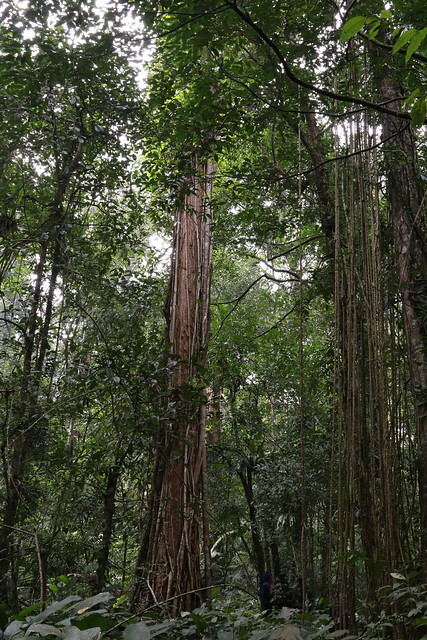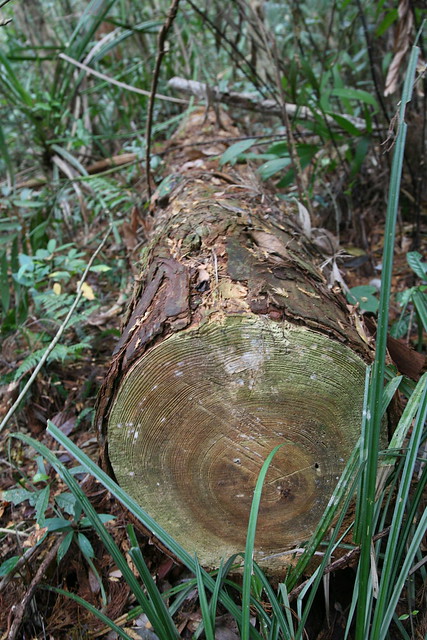Located in central Laos, the Nakai plateau is a shelf of land at about 300 meters resting at the western edge of the Annamite Mountains. This range of mixed limestone, sandstone, granitic rocks, and gneisses runs roughly north west and south east, dividing Vietnam and Laos. These mountains are the major watershed of Lao, and are an important ecoregion hosting many endemic species. Time, climate, and geological processes have generated unique elevated habitat, and it is here, along the Ho Chi Minh Trail, that the majestic — and critically endangered — Chinese swamp cypress grows.
 By David McGuire In January, a National Geographic Explorer’s expedition trekked into
By David McGuire In January, a National Geographic Explorer’s expedition trekked into
the forests of Laos to study and document the endangered Chinese
swamp cypress.
Until recenlty, this Laos population of the endangered Chinese swamp cypress was unknown to science. A decade ago, the conservation science community was aware of only 250 of these trees in the wild, mostly a remnant population in Vietnam. The majority were just spindly young things poking their way out of Vietnamese coffee plantations. That changed in 2007 when my colleague Dr. Gretchen Coffman, a wetland restoration ecologist, literally stumbled upon a remote and unrecorded population of Chinese swamp cypress while surveying wetland wildlife habitat in Laos in an area to be flooded by a huge dam, the Nam Theun 2. After tripping over a cypress knee, she looked up at a red-barked giant that resembled a cross between a bald cypress and a coastal redwood.
This tree has a very limited range and specialized habitat, and due to its rot-resistant wood (similar to rosewood), it is highly sought after for building boats and houses. Locally extinct in China, the trees were believed to only exist in Vietnam where most had been removed. Coffman’s discovery offered proof that the Chinese swamp cypress survived also in Laos, raising hope that it might be saved from extinction. In January 2015, we embarked on a second trip as part of a National Geographic Explorer’s expedition to document, sample, and learn more about this tree, its habitat, and the associsted ecosystem. It was during this trip that we discovered a once-hidden, still flourishing population of hundreds of large cypress trees high above areas flooded by Nam Theiun 2 in the Nam Theun National Protected area.
Just after New Years Day, 2015, following a trip to one more government office and one more meeting, our expedition team received the final approvals we needed and made successful entry onto the mountain slopes to start our work. We began our trip during the dry season and the cool air was filled with the red dust and smoke from burning stumps and rice fields. At 8°C ( 45°F) the nights were considerably colder than in the river plane and we were preparing for the next week of camping at elevations near 600 meters.
 By David McGuire An illegally felled Chinese swamp cypress. Due to its rot-resistant wood,
By David McGuire An illegally felled Chinese swamp cypress. Due to its rot-resistant wood,
the tree is highly sought after by poachers.
Bags of rice, boxes of noodles and whatever produce we could bring were piled into bags and boxes. With the pots, pans, and a nifty bamboo rice steamer used on an open fire, we planned to supplement our diet with plants and leaves from the forest. Our Lao counterparts wouldn’t let us forget the chili peppers, sticky rice, and fermented fish called Padeang, which is quite aromatic.
After 15 days and three more forays into the mountains, we awaited approval to head up to the highlands one last time. Having lost my bag on the flight to Laos, I was without warm clothes and had to make do with the camera batteries, cards, and gear I had. With little clothing, instead of my favorite Patagonia gear, I wore my heavy dew sodden Dolphin Club Sweatshirt and polyester Vietnamese sweats. My light boots had melted while drying near the fire and I was down to a pair of sandals bound with twine.
Sandals worked fine on the longtail boats but were a challenge when walking, sliding and sinking through the muck in the wetland habitat of the cypress forests. We disembarked from the headwaters of the river, and rode by Tok Tok — a three wheeled tractor that serves as a mechanical water buffalo — over mountain passes and into valleys, even wading across a river where the bridge had washed away, to finally arrive at the village that was the gateway to our final stand of ancient trees.
The headman was not home but his wife graciously allowed us to camp on the floor out of the cold while a young man was sent to the next village to inform him. The next day Sim Than arrived and greeted his uninvited house guests generously but cautiously. He allowed us to document a stand of trees at the edge of rice paddies nearby, where the huge stumps of removed cypress stood as headstones, but he hesitated when we asked to move up the mountain and camp. The land was shared by three villages and all the headmen had to give us permission, he explained. We had become good at waiting and did what work we could while the surrounding headmen gathered into a small conference
 By David McGuire Dr. Coffman and a Lao student measure the height of trees.
By David McGuire Dr. Coffman and a Lao student measure the height of trees.
The leaders were curious why we had traveled so far, why we were so interested in this tree, and what we would do with the information once we left. They were anxious for us to tell the government that they needed energy and better health care. One headman suggested the forest might be better protected in exchange for a turbine. Ultimately, they granted us access, and at our final destination, with the help of the headman, we recorded nearly 100 additional Chinese swamp cypress, bringing our total count to over 500.
Seeing these rare trees and other wildlife in the remote highlands created mixed feelings. The cypress were protected by the difficult access to the area and the presence of remnant unexploded ordinance from the Vietnam War. In each village, a local militia had escorted us into the trackless forest, equipped with a Vietnam era Kalashnikov rife, Chinese made fatigues, and flip flop sandals. These areas are remnants of wildness in a region undergoing rapid growth and development, yet retarded by the ghosts of a terrible conflict.
During our trip, we also found signs of tree extraction, including freshly cut trees, wood planks, and shingles deep in the forest. We were told that poachers cross over the Vietnam border and poach these trees and other valuable woods like Rosewood, cutting the logs into sections and hiking them out. But we were far from the border and in difficult terrain. Local consumption is more likely driving tree-felling, and in nearby villages we saw roof tiles and siding made of the weather resistant wood, as well as cypress boats plying the rivers. At one point, our guide showed us a stump from a tree he felled in 1965 to build his house, long before the trees became protected.
Laos Highland tribes live off the land and the nation does not have enough resources to both support public services and protect wildlife. Village leaders are striving to provide a better life for their people and the need for cleared land and energy is growing, putting pressure on rare species like the cypress, and endemic wildlife like the Muntjac, a small endangered antelope. Rice paddies and cassava fields — and corresponding tree cutting — are moving up the mountain into the National Protected Area. The resulting habitat loss amplifies the threats from poaching, but also reflects the needs of a growing population seeking to feed itself. Without providing long-term value to local communities, these forest resources will inevitably be used by the growing population for subsistence, or will be sold or lost to poachers from over the border.
This tension was reflected in our work. Resource managers are ill equipped to protect such a large area, and our colleagues had never visited the highlands. In addition to finding and documenting most of the Chinese swamp cypress in the region, our greatest challenge throughout the trip was to work together with wildlife patrols and local villagers to help protect this crucial old-growth forested wetland ecosystem.
Great care must be made in sharing the locations of the endangered cypress populations we documented so that they are not revealed to poachers. I suspect we will return to Laos and Vietnam to gather more data and material for genetic analysis that might prove helpful for conservation of this giant treee. We also hope to make good on our promise to assist local leaders in their effort to protect the wild forests of Laos.
We don’t have a paywall because, as a nonprofit publication, our mission is to inform, educate and inspire action to protect our living world. Which is why we rely on readers like you for support. If you believe in the work we do, please consider making a tax-deductible year-end donation to our Green Journalism Fund.
Donate